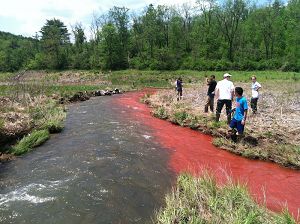Hydrogeophysics Research Group
Image: Downstream view of tracer test during Hydrogeophysics Undergraduate Research Workshop 2012.
This group is tagged with:
-
Hydrogeophysics: The hydrogeology group at the Shale Hills CZO has been exploring solute transport in the shale and shale-produced soils.
1) What is the importance of the interface between the shale bedrock and the regolith above with respect to flow within the watershed? Is the shale bedrock “impermeable”?
2) How does dead-end pore space affect estimated ages of water at the site?
3) How do the parameters controlling solute transport operate within the watershed?To answer these questions we have been coupling lab and field studies. We have drilled four 17-m deep bedrock wells using a portable drill, and have completed a suite of borehole logging in these wells, including (1) spectral gamma, which measures gamma rays emitted by isotopes of the uranium decay series, the thorium decay series, and potassium-40; (2) caliper, which measures the borehole diameter to locate broken and fractured zone; (3) fluid resistivity, which measures the total dissolved solids in the water column (4) fluid temperature; (5) heat-pulse flowmeter, which indicates the rate and direction of vertical flow within a borehole; and (6) optical televiewer, which provides a continuous, oriented, true-color 360o image of the borehole wall. We additionally conducted slug and pump tests to estimate the effective transmissivity of subsurface at this site. We have also been conducting tracer tests at the field and lab scale.
From the drilling and wireline logs, we can make the following conclusions: there is a “slow drilling” zone around 6-7 m below land surface, above which is highly weathered shale that is reddish in color, beneath which is largely unfractured blue-grey shale. The natural gamma data similar indicate a higher percentage of clays with depth than in the top 6 m that shows variability in shale bedrock density down to about 6 m.
In field-scale and lab-scale tracer tests, observed transport behavior appears inconsistent with the standard advective-dispersive model. We have collected and analyzed breakthrough curve (BTC) data to identify the parameters controlling transport. A series of undisturbed fully saturated soil cores were collected in a continuous hole extending across the soil profile vertically at one location to quantify how solute transport behavior changes with physical and chemical weathering. Additionally, we performed a field scale doublet tracer test to determine transport behavior within the weathered shale bedrock. Hydraulic conductivity and porosity are as low as 10-15 m/s and 0.035, respectively, in the shale bedrock and range as high as 10-5 m/s and 0.45, respectively, in the shallow soils. Bromide BTCs demonstrated significant anomalous tailing in soil cores and shale bedrock, which do not fit classical advection-dispersion processes. To quantify the behavior, numerical simulation of solute transport was carried out with both a mobile-immobile (MIM) model and a continuous-time random walk (CTRW) approach. 1-D MIM modeling results on the soil cores yielded low mass transfer rates (< 1/d) coupled with large immobile domains and revealed that solutes were transported within only 30-40% of the total pore space. MIM modeling results also suggested that immobile porosity is a combination of soil texture, fracture spacing, and porosity development on shale fragments. Similarly, the field scale doublet tracer test between boreholes indicated fractures are controlling transport and the surrounding shale matrix has a large potential to store and retard solute movement. 1-D CTRW results yielded a parameter set indicative of a transport regime that is consistently non-Fickian across the vertical length of the soil profile, identified solute tracer velocities are up to 50 times greater than the average fluid velocity, predicted that anomalous transport behavior could extend for significant periods of time, and identified the need to incorporate a continuum of mass transfer rates to accurately predict and describe the observed tailing behavior. These modeling results confirmed the important role of preferential flow paths, fractures, and mass transfer between more- and less-mobile fluid domains, and established the need to incorporate a mass transfer process that utilizes a distribution of mass transfer rates.
Contact: Kamini Singha (PI)
Figure 1. Location of ground water wells.
Figure 2. Terryl Daniels (PSU undergrad) drills wells with the Portadrill Mini.
Figure 3. Assembly of an optical televiewer, one of many logging tools. Nate Wysocki (PSU undergrad) and Maurice Dukes (Fort Valley State undergrad) control the operation.
Figure 4. Preliminary wireline logs from the four new wells, with gamma on the left and caliper on the right. Well CZMW 1 is plotted in blue, CZMW 2 in green, CZMW 3 in yellow, and CZMW in red.
Figure 5. Optical televiewer logs shown for two wells, CZMW 1 on the left and CZMW 4 on the right.
-
Contacts
-
Boulder, Shale Hills, INVESTIGATOR
3 People
INVESTIGATOR, PostDoc
.(JavaScript must be enabled to view this email address)
Seismology, Near Surface Geophysics
INVESTIGATOR, Visiting/Affiliate, COLLABORATOR
.(JavaScript must be enabled to view this email address)
Near surface geophysics, hydrology
Cross-CZO INVESTIGATOR
.(JavaScript must be enabled to view this email address)
Mines
Hydrogeology, environmental geophysics, geostatistics
Alumni-Former
INVESTIGATOR, PostDoc
.(JavaScript must be enabled to view this email address)
Geophysics, Hydrology
GRAD STUDENT
.(JavaScript must be enabled to view this email address)
Hydrogeology
UNDERGRAD
.(JavaScript must be enabled to view this email address)
Temple
Geology and Geophysics
-
-
Featured Publications
2011
Quantifying Solute Transport at the Shale Hills Critical Zone Observatory. Kuntz, B., Rubin, S., Berkowitz, B., and Singha, K. (2011): Vadose Zone Journal 10:843-857
2010
Laboratory, Field, and Modeling Analysis of Solute Transport Behavior at the Shale Hills Critical Zone Observatory,. Kuntz, B. (2010): Master of Science, Geosciences, The Pennsylvania State University, p. 73
Explore Further








